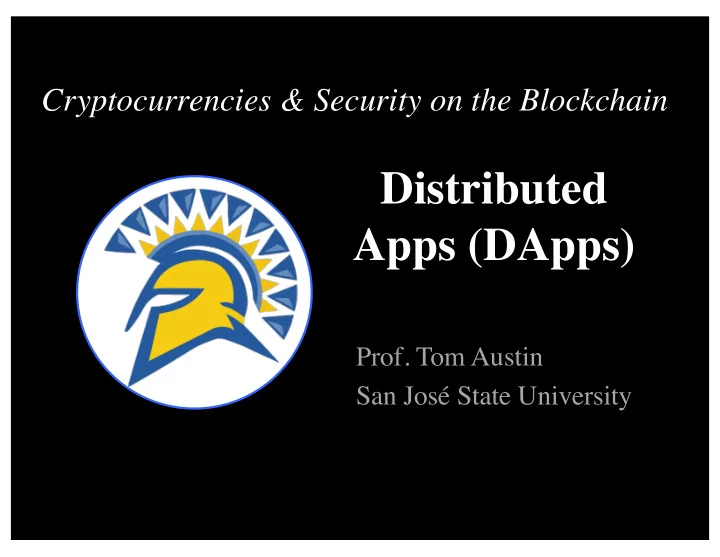

Cryptocurrencies & Security on the Blockchain Distributed Apps (DApps) Prof. Tom Austin San José State University
Evolution of the Web • Web 1.0 – Few content creators • Web 2.0 – User-generated content – Social media – Applications still centralized • Web 3.0 – Decentralized applications
What Makes a DApp? • Smart contracts – Business-logic, application state, etc. – Replace server-side layer • Frontend – HTML, JavaScript, etc. – Web3.js – communication with smart contract • Other components – Storage: IPFS or Swarm – Messaging: Whisper
Taken from Mastering Ethereum
Advantages of a DApp • Advantages: – Censorship-resistance – Transparency – Resilience • Disadvantages: – Pretty much everything else
DApp Development Process 1. Compile Solidity code 2. Run Ganache for testing 3. Deploy code 4. Interact through web3.js
Solidity Compiler • Produces: – EVM bytecode – Application Binary Interface (ABI) • Usage: $solcjs --bin --abi ContractFile.sol • Installed through npm. – NOTE: There are other solidity compilers.
Solidity Compiler Example (in class)
ABI • Specifies interface for other tools to use. • Produced by Solidity compiler. • Sample (shown in class).
Ganache • "One-click blockchain" – Blockchain emulator • Part of Truffle tool suite • Install through npm • Creates 10 accounts with 100 ether
Web3.js • Interacts with Smart Contract • Works with either node or browser • WARNING: a little buggy
DApp example (in class)
Note on Using Strings • Many applications use bytes32 rather than string . – Lower gas price. • Web3.js offers utility functions to convert: – web3.utils.hexToAscii converts bytes to a string – web3.utils.asciiToHex converts a string to bytes
Lab: Auction DApp • Build a DApp for an auction • Details in Canvas
Recommend
More recommend